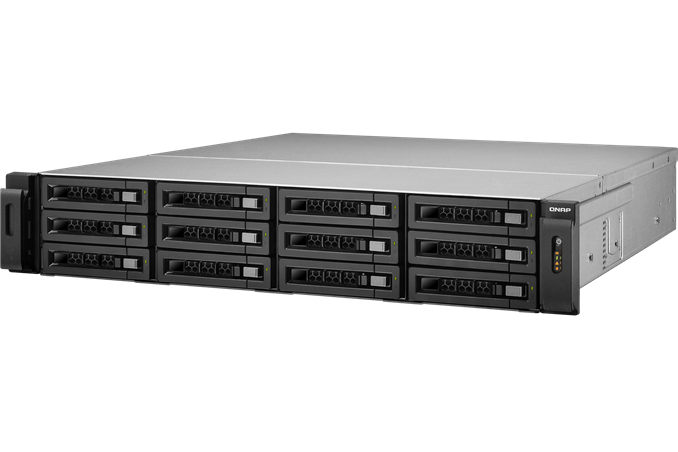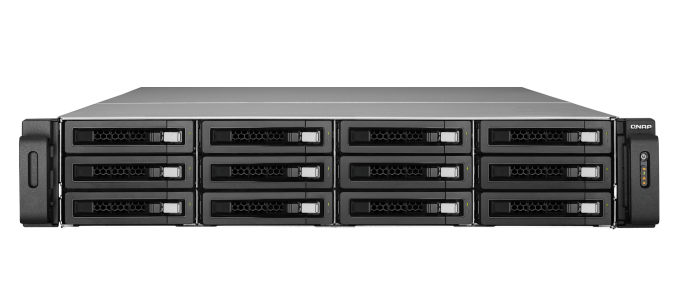QNAP's TS-EC1279U-RP 12-bay Flagship Rackmount NAS Review
by Ganesh T S on April 29, 2013 4:30 PM EST- Posted in
- Enterprise
- Storage
- NAS
- QNAP

Introduction
Our enterprise NAS reviews have focused on Atom-based desktop form factor systems till now. These units have enough performance for a moderately sized workgroup and lack some of the essential features in the enterprise space such as acceptable performance with encrypted volumes. A number of readers have mailed in asking for more coverage of the NAS market straddling the high-end NAS and the NAS - SAN (storage area network) hybrid space. Models catering to this space come in the rackmount form factor and are based on more powerful processors such as the Core series or the Xeon series.
QNAP's 12-bay flagship unit is the TS-EC1279U-RP. Based on the Xeon E3-1225 processor, this 2U rackmount system comes with twelve hot-swappable bays and 4GB of ECC RAM. Both SATA and SAS disks in 3.5" as well as 2.5" form factor are supported.
The last QNAP unit that we reviewed was the TS-659 Pro II. Around that time, QNAP was struggling with some data corruption issues in their firmware. We were hesitant to carry on reviewing QNAP's products while this issue remained outstanding. The solution came in the form of FW release v3.7.1 almost a year after the problem was first reported. We have been using a couple of QNAP units in-house with later firmware releases and couldn't replicate the bug in our environment. This gave us enough confidence to request QNAP for one of their latest NAS units. They obliged with the TS-1279U-RP, and it also marks our foray into reviewing units in the rackmount space.
The specifications of the TS-EC1279U-RP are as below:
| QNAP TS-EC1279U-RP Specifications | |
| Processor | Intel Xeon E3-1225 (4C, 3.1 GHz) |
| RAM | 4 GB DDR3 ECC RAM (Upgradable to 8 GB) |
| Flash | 512MB DOM |
| Drive Bays | 12x 3.5"/2.5" SATA / SAS 6 Gbps HDD / SSD |
| Network Links | 4x 1 GbE (Two links upgradable to 10 GbE) |
| USB Slots | 2x USB 3.0 / 4x USB 2.0 |
| eSATA Slots | 2x |
| Expansion Slots | 2x (Network or Storage Expansion) |
| VGA | Reserved for Maintenance |
| Full Specifications Link | QNAP TS-EC1279U-RP Hardware Specs |
In the rest of the review, I will cover some unboxing and setup impressions. A detailed description of the testbed setup and testing methodology is followed by performance numbers in both single and multi-client modes. As requested by multiple readers, we will also briefly cover performance with encryption enabled. In the final section, power consumption numbers as well as RAID rebuild times will be covered along with some closing notes.











23 Comments
View All Comments
Jeff7181 - Tuesday, April 30, 2013 - link
EMC, Hitachi and NetApp provide enterprise class NAS and SAN arrays. This, nor any, QNAP product is anywhere near that level.Walkeer - Thursday, May 9, 2013 - link
agreed, plus NAS is not really enterprise anyway since these is SANdavegraham - Tuesday, April 30, 2013 - link
Ganesh,having worked in the storage industry (and now working for an enterprise and carrier networking company doing data center architecture and design) QNAP, Drobo, et al. aren't names that carry any weight for enterprise-class storage. The systems I deal with (for example, EMC Symmetrix VMAX 40K) are considered "enterprise class" storage systems (99.999% uptime, SSD caching and tiering, finely tuned atomic memory and storage access, multiple active processing storage engines/directors, fibre channel/FCoE/iSCSI front ends, extensive API command/control sets, replication [local & remote], snapshotting/cloning, etc.). As Jeff7181 notes below, these stand alone in a class by themselves.
cheers,
D
Walkeer - Thursday, May 9, 2013 - link
agreed, this is a SOHO toy...jaziniho - Wednesday, May 1, 2013 - link
Unless this comes in a model with dual controllers (not just dual PSUs), then it's squarely in the SMB rather than enterprise space.Support for SAS as well as SATA disks would also be high on list of potential requirements for enterprise. With RAID rebuild times on large drives so long, you need disks with decent reliability to give you more confidence in making it through the rebuild.
aloginame - Saturday, May 11, 2013 - link
I agree with the fact that this QNAP is not really a "Enterprise" or "High-End" solution for NAS, however, I have to disagree when it is being compared to something like EMC Symmetrix VMAX 40K, for those are really SAN solutions and not NAS.golemite - Monday, April 29, 2013 - link
Hi Ganesh, any chance of getting reviews of lower end rackmount NAS systems like the Synology RS812/812+?ganeshts - Wednesday, May 1, 2013 - link
We have the Synology RS10613sx+ in the pipeline, but it costs approx. twice that of the TS-EC1279U-RP and caters to users who require more performance / features.mmayrand - Tuesday, April 30, 2013 - link
So, you spend $3500 for box plus 12 SSD (not free) and you get the 1/3 of the effective bandwidth of a single SSD plugged in a $300 PC. Is there a point to these NAS boxes?davegraham - Tuesday, April 30, 2013 - link
Mmayrand,the concept behind a NAS box is shareable storage across N-number of users in a SoHo or SMB environment. at that point, it makes more sense to have a common pool of storage that can be "protected" (remember, RAID is NOT backup) and utilized more efficiently, than a scattered or siloed collection of independent disk in a laptop or desktop.
it also is a basic requirement for most virtualization (the concept of shared storage) solutions to maintain high availability and portability for virtual machines within a cluster. As a standalone box, you're right, you can hit better performance #'s because you're just straddling a PCIe bus vs. ethernet. however, change the venue and you're looking at a more ideal solution.
D